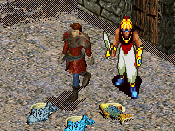Reply to My job
If you don't have an account, just leave the password field blank.
If you are one of the ones who asked what I do, here is what I can tell you.
I am stationed here and I am currently assigned to the 66th Combat Rescue Sqaudron (which is under the Air Force Special Operations Command) doing what is called Air Crew Life Support. In my current position I primary maintain Night Vision Goggles, GPS systems and survival equipment used by Air Crew in case of emergency egress proceedures. Basically, I make sure they equipment works when they need it, or they may die because of it. Here is a breif exerpt of what my squadron does.
The primary mission of the 66th Rescue Squadron is worldwide combat rescue in support of combat air forces. The 66 RQS is one of only four Air Force active-duty HH-60 combat rescue units and is geared for worldwide deployment. The 66 RQS performs other vital functions in addition to worldwide combat rescue. Its secondary mission is to provide rescue support for air operations over the Nellis Range Complex and back-up rescue for civilian agencies in the local area and the greater Southwestern United States. Depending on the mission, a typical rescue crew includes a pilot, co-pilot, flight engineer (FE), gunner and two pararescuemen (PJs). PJs are qualified combat paramedics, scuba divers, parachutists, mountain climbers and survivalists.
I am stationed here and I am currently assigned to the 66th Combat Rescue Sqaudron (which is under the Air Force Special Operations Command) doing what is called Air Crew Life Support. In my current position I primary maintain Night Vision Goggles, GPS systems and survival equipment used by Air Crew in case of emergency egress proceedures. Basically, I make sure they equipment works when they need it, or they may die because of it. Here is a breif exerpt of what my squadron does.
The primary mission of the 66th Rescue Squadron is worldwide combat rescue in support of combat air forces. The 66 RQS is one of only four Air Force active-duty HH-60 combat rescue units and is geared for worldwide deployment. The 66 RQS performs other vital functions in addition to worldwide combat rescue. Its secondary mission is to provide rescue support for air operations over the Nellis Range Complex and back-up rescue for civilian agencies in the local area and the greater Southwestern United States. Depending on the mission, a typical rescue crew includes a pilot, co-pilot, flight engineer (FE), gunner and two pararescuemen (PJs). PJs are qualified combat paramedics, scuba divers, parachutists, mountain climbers and survivalists.









